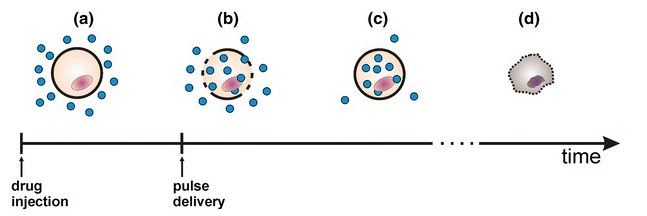How to use Electrochemotherapy?
The drugs can be given by different routes of administration, they can be injected either intravenously or intra-tumourally. The prerequisite is that, at the time of the application of electric pulses to the tumour, a sufficient amount of drug is present in the tu-mour. Therefore, after intravenous drug administration into small laboratory animals (4 mg/kg of cisplatin or 0.5 mg/kg bleomycin), only a few minutes’ interval is needed to reach the maximal drug concentration in the tumours. After intratumoural administration, this interval is even shorter and the ap-plication of electric pulses has to follow the administration of the drug as soon as possible (within a minute)
In electrochemotherapy, the optimal antitumour effectiveness is achieved when electric pulses are given at the time of the highest extracellular concentration of hydrophilic chemotherapeutic drug in the tumour, thereby increasing their transport through the plasma membrane towards their intracellular targets.

Tumors of less than 3 cm were found to be more likely to respond, having a partial or complete response rate of 91% (82 of 90). Tumors regressed in most cases within 4 to 6 weeks, when the superficial eschar fell off and a good cosmetic effect was observed. It is likely that larger and partially responding tumors would benefit from repeat electrochemotherapy within 1 month of the initial treatment
The antitumour effectiveness is dependent on the amplitude, number and duration of the electric pulses applied. Several studies in which parallel plate electrodes were used for surface tumours showed that an amplitude over distance ratio above 1000 V/cm is needed for tumour electroporation, and that above 1500 V/cm, irreversible changes in the normal tissues adjacent to the tumour occur; so, the window for effective and safe electrochemotherapy is between 1000 -1500 V/cm. in most studies the amplitude over distance ratio of 1300 V/cm induced good anti-tumour effectiveness without sub-optimal electroporation of the tissue or damage to the tissue due to irreversible cell permeabilization. Repetition frequencies of the pulses for electrochemotherapy are either 1 Hz or 5 kHz. The minimal number of the pulses used is 4; most studies use 8 electric pulses of 100 μs. The 5-kHz frequency can be selected in patients with multiple nodules as it exceeds the frequency of tetanic contraction, so that the 8 x 100-microsecond pulses were felt by the patient as only one sensation.
Besides membrane electroporation, which facilitates drug transport and its accumu-lation in the cell, other mechanisms that are involved in antitumour effectiveness of electrochemotherapy is that the electric pulses to the tissues induces a transient, and reversible reduction of blood flow. The restoration of the blood flow in normal tissue is much faster than of that in tumours.
This vascular constriction is advantageous for electrochemotherapy because drugs present in the tumor tissue are retained at the time when the cells in the tissue are permeabilized, thus enhancing the potential for intracellular traffic. This phenomenon has been termed the “vascular lock.” It is suggested that the effect of the vascular lock is more prolonged in tumors than in normal tissue; tumors have a chaotic irregular microvasculature, with fenestrated capillaries such that no continuous barrier exists between the vascular compartment and the interstitial fluid.